IT Ethics Case Study: Professional Conduct and Ethical Obligations
VerifiedAdded on 2023/04/26
|9
|2083
|256
Case Study
AI Summary
This assignment presents a case study involving an HCI consultant facing an ethical dilemma when discovering that Company A has copied Company B's GUI for a new accounting product. The analysis explores the consultant's obligations under contractual arrangements and the ACS Code of Professional Conduct, focusing on values such as honesty, competence, and professionalism. The study further applies ethical theories like Utilitarianism, Deontology, and Virtue Theory to evaluate the ethical implications of the situation and the actions of the involved parties. The discussion extends to the importance of transparency in machine learning algorithms, highlighting the balance between openness and the potential for privacy violations and competitive disadvantages, and concludes by emphasizing the distinct nature and significance of professional ethics in maintaining reliability and trust.
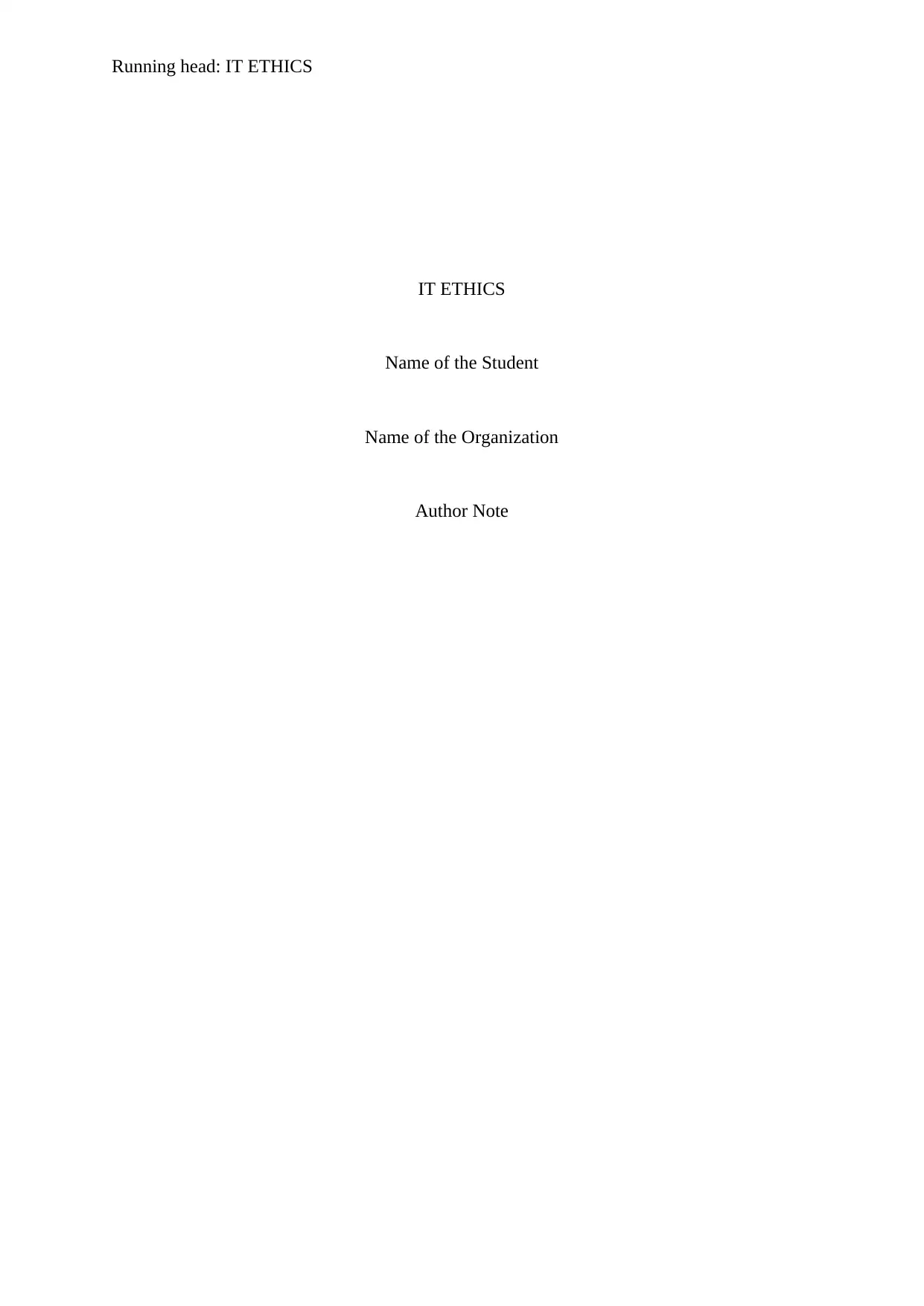
Running head: IT ETHICS
IT ETHICS
Name of the Student
Name of the Organization
Author Note
IT ETHICS
Name of the Student
Name of the Organization
Author Note
Paraphrase This Document
Need a fresh take? Get an instant paraphrase of this document with our AI Paraphraser
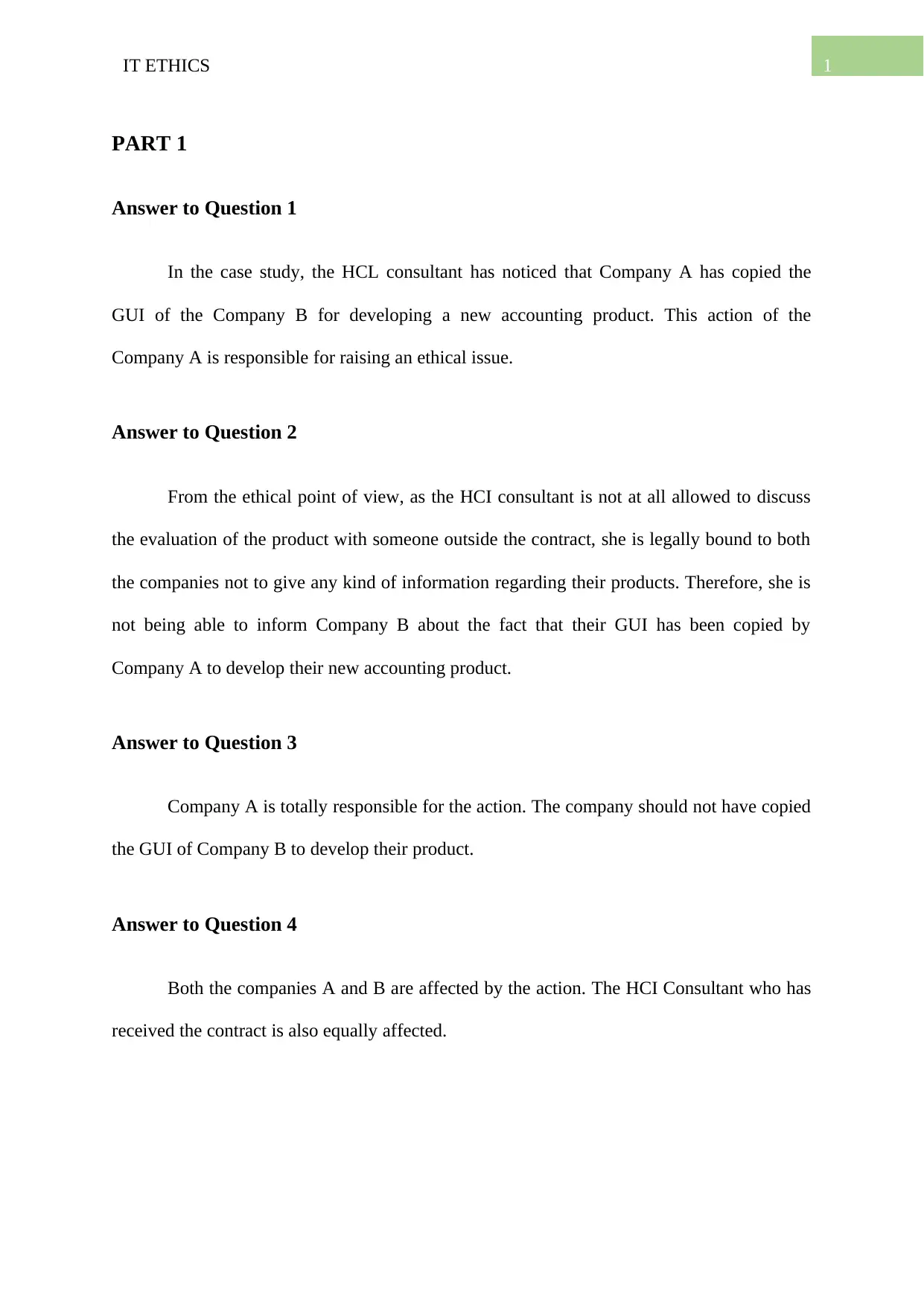
1IT ETHICS
PART 1
Answer to Question 1
In the case study, the HCL consultant has noticed that Company A has copied the
GUI of the Company B for developing a new accounting product. This action of the
Company A is responsible for raising an ethical issue.
Answer to Question 2
From the ethical point of view, as the HCI consultant is not at all allowed to discuss
the evaluation of the product with someone outside the contract, she is legally bound to both
the companies not to give any kind of information regarding their products. Therefore, she is
not being able to inform Company B about the fact that their GUI has been copied by
Company A to develop their new accounting product.
Answer to Question 3
Company A is totally responsible for the action. The company should not have copied
the GUI of Company B to develop their product.
Answer to Question 4
Both the companies A and B are affected by the action. The HCI Consultant who has
received the contract is also equally affected.
PART 1
Answer to Question 1
In the case study, the HCL consultant has noticed that Company A has copied the
GUI of the Company B for developing a new accounting product. This action of the
Company A is responsible for raising an ethical issue.
Answer to Question 2
From the ethical point of view, as the HCI consultant is not at all allowed to discuss
the evaluation of the product with someone outside the contract, she is legally bound to both
the companies not to give any kind of information regarding their products. Therefore, she is
not being able to inform Company B about the fact that their GUI has been copied by
Company A to develop their new accounting product.
Answer to Question 3
Company A is totally responsible for the action. The company should not have copied
the GUI of Company B to develop their product.
Answer to Question 4
Both the companies A and B are affected by the action. The HCI Consultant who has
received the contract is also equally affected.
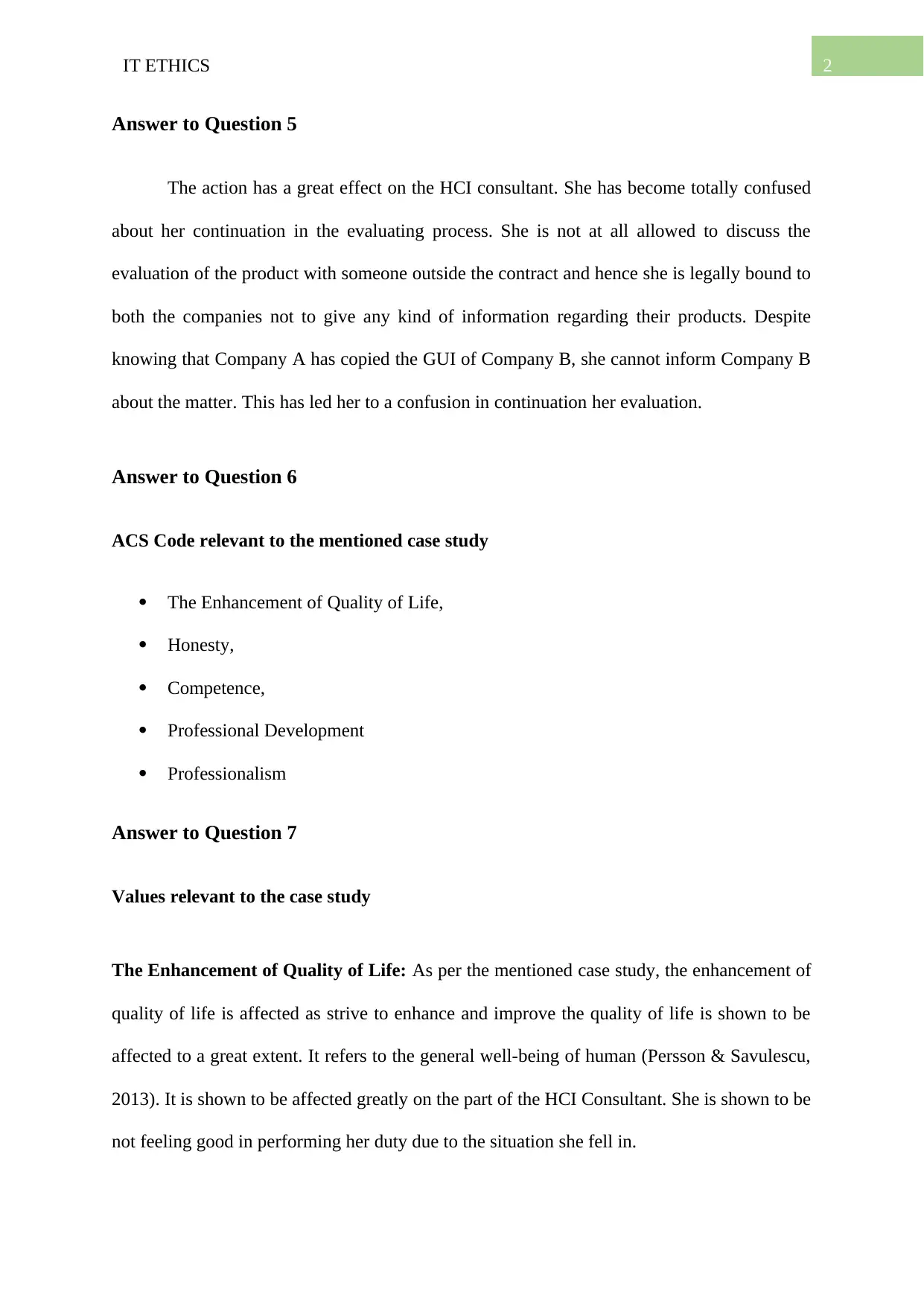
2IT ETHICS
Answer to Question 5
The action has a great effect on the HCI consultant. She has become totally confused
about her continuation in the evaluating process. She is not at all allowed to discuss the
evaluation of the product with someone outside the contract and hence she is legally bound to
both the companies not to give any kind of information regarding their products. Despite
knowing that Company A has copied the GUI of Company B, she cannot inform Company B
about the matter. This has led her to a confusion in continuation her evaluation.
Answer to Question 6
ACS Code relevant to the mentioned case study
The Enhancement of Quality of Life,
Honesty,
Competence,
Professional Development
Professionalism
Answer to Question 7
Values relevant to the case study
The Enhancement of Quality of Life: As per the mentioned case study, the enhancement of
quality of life is affected as strive to enhance and improve the quality of life is shown to be
affected to a great extent. It refers to the general well-being of human (Persson & Savulescu,
2013). It is shown to be affected greatly on the part of the HCI Consultant. She is shown to be
not feeling good in performing her duty due to the situation she fell in.
Answer to Question 5
The action has a great effect on the HCI consultant. She has become totally confused
about her continuation in the evaluating process. She is not at all allowed to discuss the
evaluation of the product with someone outside the contract and hence she is legally bound to
both the companies not to give any kind of information regarding their products. Despite
knowing that Company A has copied the GUI of Company B, she cannot inform Company B
about the matter. This has led her to a confusion in continuation her evaluation.
Answer to Question 6
ACS Code relevant to the mentioned case study
The Enhancement of Quality of Life,
Honesty,
Competence,
Professional Development
Professionalism
Answer to Question 7
Values relevant to the case study
The Enhancement of Quality of Life: As per the mentioned case study, the enhancement of
quality of life is affected as strive to enhance and improve the quality of life is shown to be
affected to a great extent. It refers to the general well-being of human (Persson & Savulescu,
2013). It is shown to be affected greatly on the part of the HCI Consultant. She is shown to be
not feeling good in performing her duty due to the situation she fell in.
⊘ This is a preview!⊘
Do you want full access?
Subscribe today to unlock all pages.

Trusted by 1+ million students worldwide
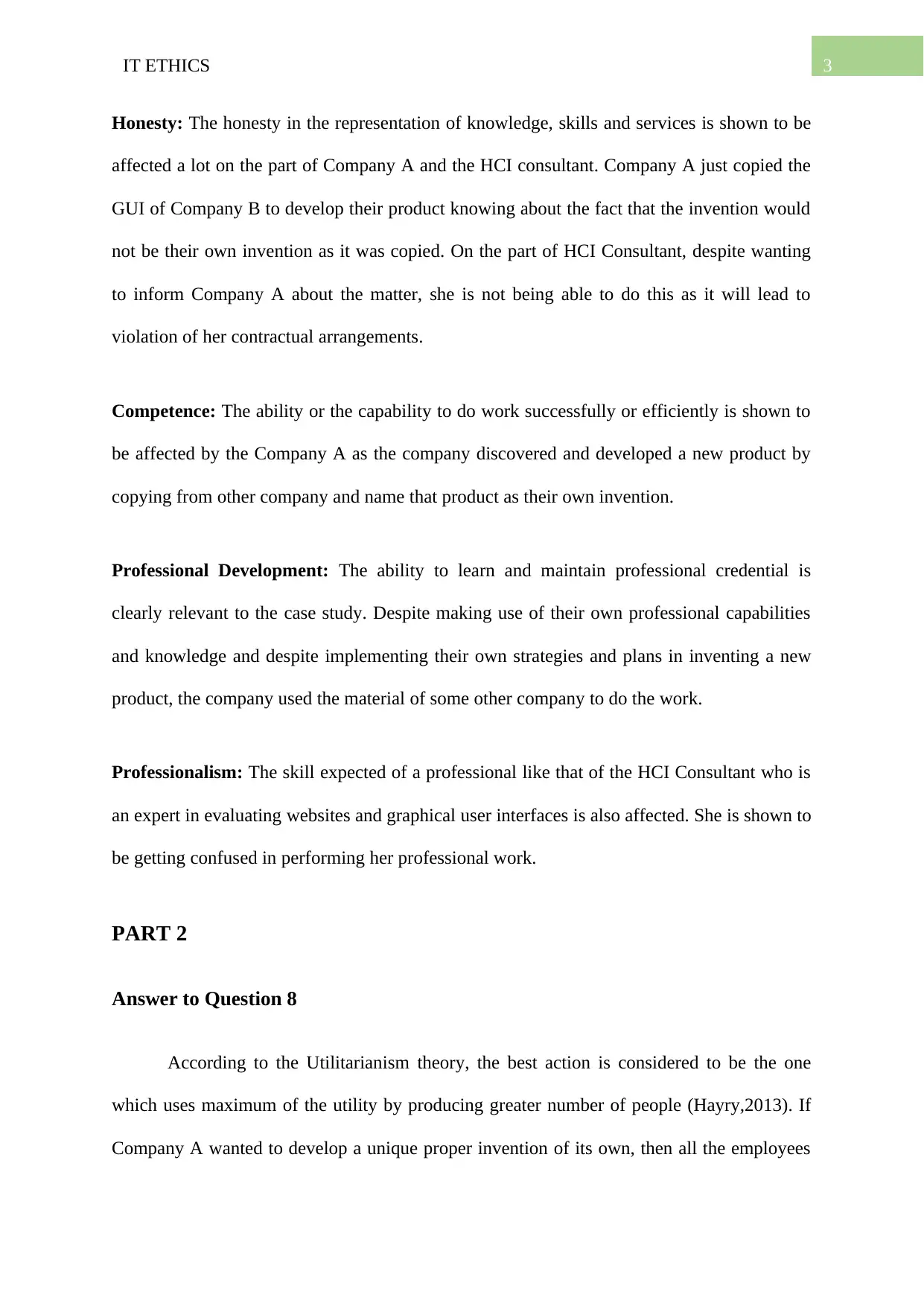
3IT ETHICS
Honesty: The honesty in the representation of knowledge, skills and services is shown to be
affected a lot on the part of Company A and the HCI consultant. Company A just copied the
GUI of Company B to develop their product knowing about the fact that the invention would
not be their own invention as it was copied. On the part of HCI Consultant, despite wanting
to inform Company A about the matter, she is not being able to do this as it will lead to
violation of her contractual arrangements.
Competence: The ability or the capability to do work successfully or efficiently is shown to
be affected by the Company A as the company discovered and developed a new product by
copying from other company and name that product as their own invention.
Professional Development: The ability to learn and maintain professional credential is
clearly relevant to the case study. Despite making use of their own professional capabilities
and knowledge and despite implementing their own strategies and plans in inventing a new
product, the company used the material of some other company to do the work.
Professionalism: The skill expected of a professional like that of the HCI Consultant who is
an expert in evaluating websites and graphical user interfaces is also affected. She is shown to
be getting confused in performing her professional work.
PART 2
Answer to Question 8
According to the Utilitarianism theory, the best action is considered to be the one
which uses maximum of the utility by producing greater number of people (Hayry,2013). If
Company A wanted to develop a unique proper invention of its own, then all the employees
Honesty: The honesty in the representation of knowledge, skills and services is shown to be
affected a lot on the part of Company A and the HCI consultant. Company A just copied the
GUI of Company B to develop their product knowing about the fact that the invention would
not be their own invention as it was copied. On the part of HCI Consultant, despite wanting
to inform Company A about the matter, she is not being able to do this as it will lead to
violation of her contractual arrangements.
Competence: The ability or the capability to do work successfully or efficiently is shown to
be affected by the Company A as the company discovered and developed a new product by
copying from other company and name that product as their own invention.
Professional Development: The ability to learn and maintain professional credential is
clearly relevant to the case study. Despite making use of their own professional capabilities
and knowledge and despite implementing their own strategies and plans in inventing a new
product, the company used the material of some other company to do the work.
Professionalism: The skill expected of a professional like that of the HCI Consultant who is
an expert in evaluating websites and graphical user interfaces is also affected. She is shown to
be getting confused in performing her professional work.
PART 2
Answer to Question 8
According to the Utilitarianism theory, the best action is considered to be the one
which uses maximum of the utility by producing greater number of people (Hayry,2013). If
Company A wanted to develop a unique proper invention of its own, then all the employees
Paraphrase This Document
Need a fresh take? Get an instant paraphrase of this document with our AI Paraphraser
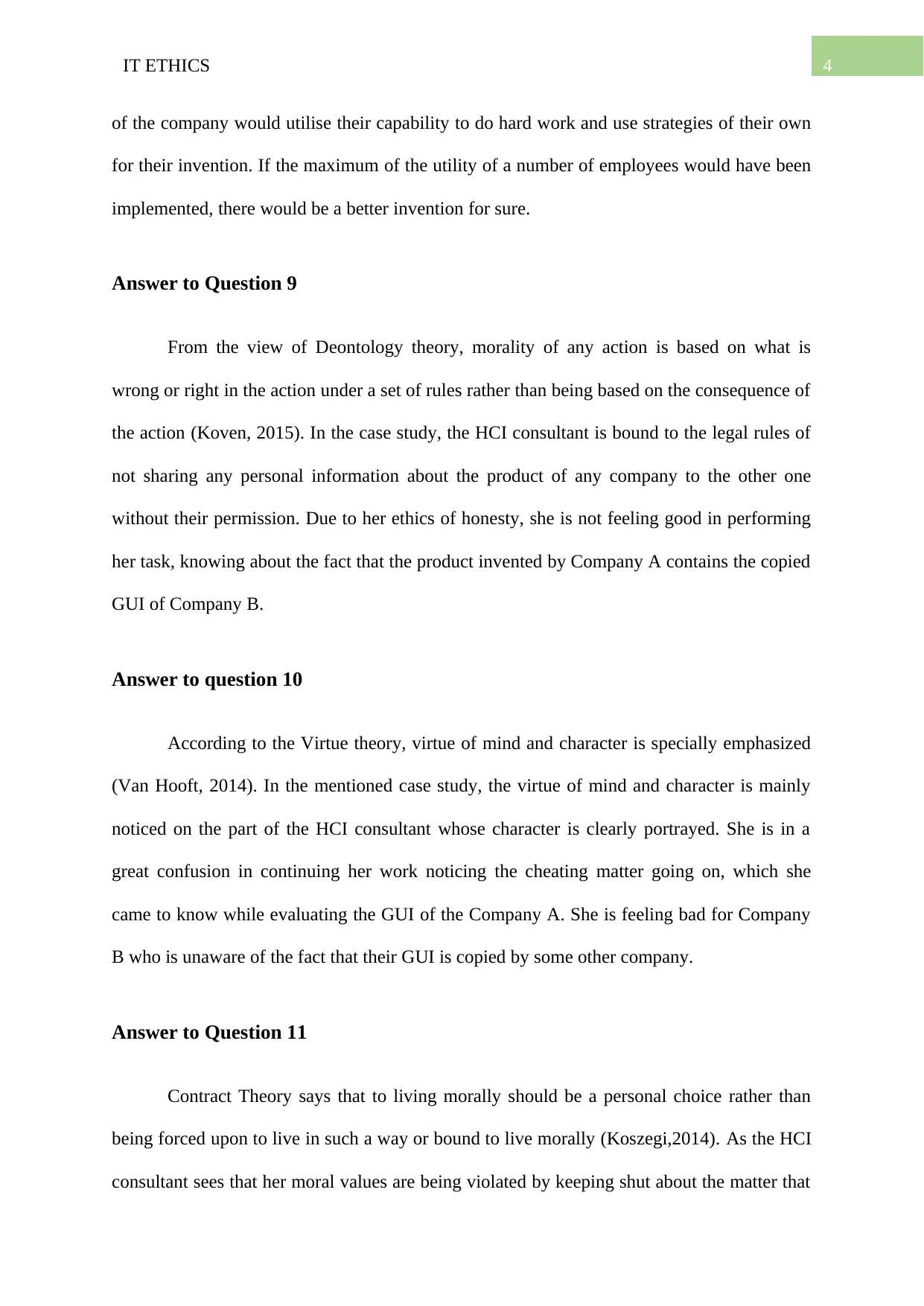
4IT ETHICS
of the company would utilise their capability to do hard work and use strategies of their own
for their invention. If the maximum of the utility of a number of employees would have been
implemented, there would be a better invention for sure.
Answer to Question 9
From the view of Deontology theory, morality of any action is based on what is
wrong or right in the action under a set of rules rather than being based on the consequence of
the action (Koven, 2015). In the case study, the HCI consultant is bound to the legal rules of
not sharing any personal information about the product of any company to the other one
without their permission. Due to her ethics of honesty, she is not feeling good in performing
her task, knowing about the fact that the product invented by Company A contains the copied
GUI of Company B.
Answer to question 10
According to the Virtue theory, virtue of mind and character is specially emphasized
(Van Hooft, 2014). In the mentioned case study, the virtue of mind and character is mainly
noticed on the part of the HCI consultant whose character is clearly portrayed. She is in a
great confusion in continuing her work noticing the cheating matter going on, which she
came to know while evaluating the GUI of the Company A. She is feeling bad for Company
B who is unaware of the fact that their GUI is copied by some other company.
Answer to Question 11
Contract Theory says that to living morally should be a personal choice rather than
being forced upon to live in such a way or bound to live morally (Koszegi,2014). As the HCI
consultant sees that her moral values are being violated by keeping shut about the matter that
of the company would utilise their capability to do hard work and use strategies of their own
for their invention. If the maximum of the utility of a number of employees would have been
implemented, there would be a better invention for sure.
Answer to Question 9
From the view of Deontology theory, morality of any action is based on what is
wrong or right in the action under a set of rules rather than being based on the consequence of
the action (Koven, 2015). In the case study, the HCI consultant is bound to the legal rules of
not sharing any personal information about the product of any company to the other one
without their permission. Due to her ethics of honesty, she is not feeling good in performing
her task, knowing about the fact that the product invented by Company A contains the copied
GUI of Company B.
Answer to question 10
According to the Virtue theory, virtue of mind and character is specially emphasized
(Van Hooft, 2014). In the mentioned case study, the virtue of mind and character is mainly
noticed on the part of the HCI consultant whose character is clearly portrayed. She is in a
great confusion in continuing her work noticing the cheating matter going on, which she
came to know while evaluating the GUI of the Company A. She is feeling bad for Company
B who is unaware of the fact that their GUI is copied by some other company.
Answer to Question 11
Contract Theory says that to living morally should be a personal choice rather than
being forced upon to live in such a way or bound to live morally (Koszegi,2014). As the HCI
consultant sees that her moral values are being violated by keeping shut about the matter that
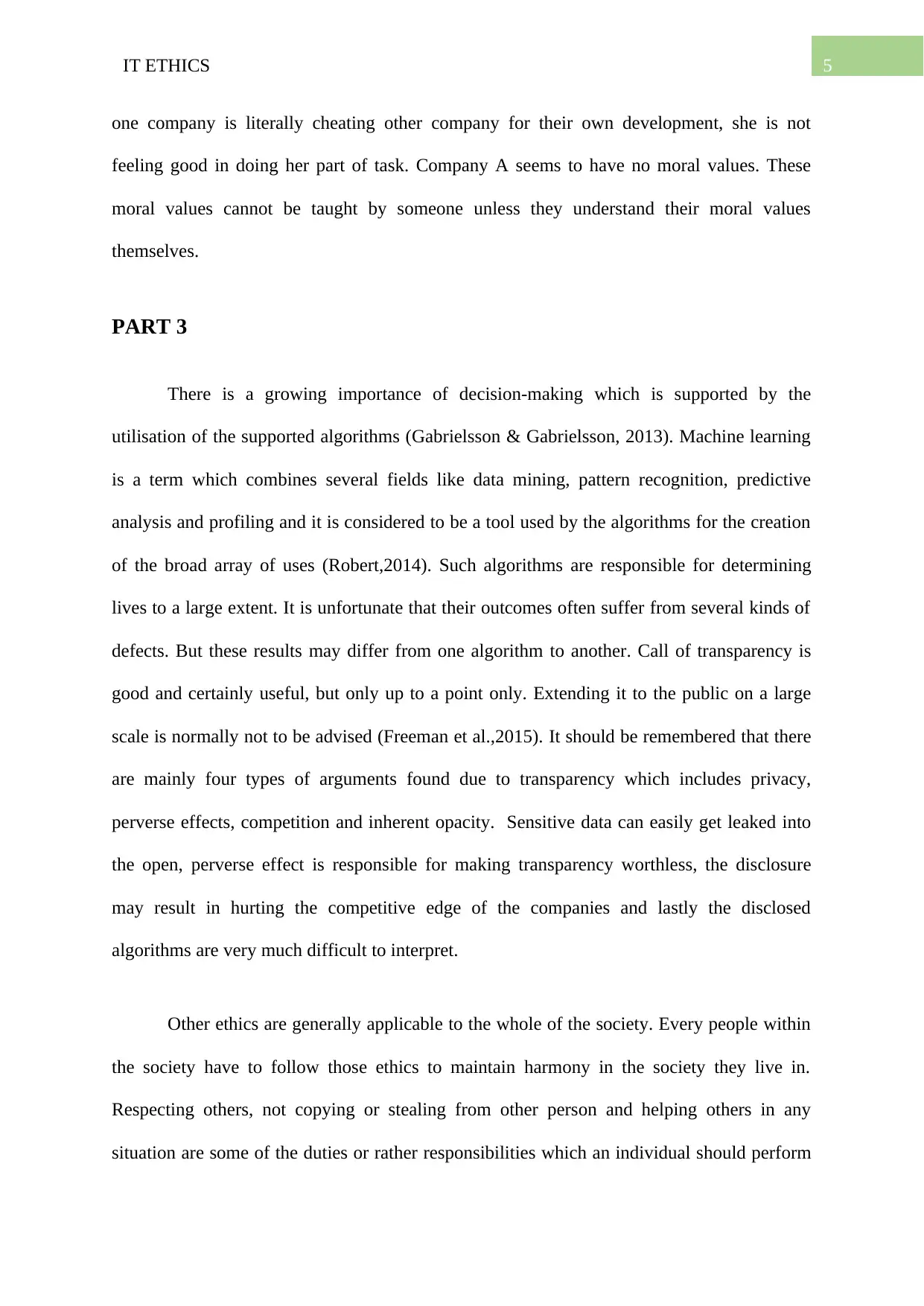
5IT ETHICS
one company is literally cheating other company for their own development, she is not
feeling good in doing her part of task. Company A seems to have no moral values. These
moral values cannot be taught by someone unless they understand their moral values
themselves.
PART 3
There is a growing importance of decision-making which is supported by the
utilisation of the supported algorithms (Gabrielsson & Gabrielsson, 2013). Machine learning
is a term which combines several fields like data mining, pattern recognition, predictive
analysis and profiling and it is considered to be a tool used by the algorithms for the creation
of the broad array of uses (Robert,2014). Such algorithms are responsible for determining
lives to a large extent. It is unfortunate that their outcomes often suffer from several kinds of
defects. But these results may differ from one algorithm to another. Call of transparency is
good and certainly useful, but only up to a point only. Extending it to the public on a large
scale is normally not to be advised (Freeman et al.,2015). It should be remembered that there
are mainly four types of arguments found due to transparency which includes privacy,
perverse effects, competition and inherent opacity. Sensitive data can easily get leaked into
the open, perverse effect is responsible for making transparency worthless, the disclosure
may result in hurting the competitive edge of the companies and lastly the disclosed
algorithms are very much difficult to interpret.
Other ethics are generally applicable to the whole of the society. Every people within
the society have to follow those ethics to maintain harmony in the society they live in.
Respecting others, not copying or stealing from other person and helping others in any
situation are some of the duties or rather responsibilities which an individual should perform
one company is literally cheating other company for their own development, she is not
feeling good in doing her part of task. Company A seems to have no moral values. These
moral values cannot be taught by someone unless they understand their moral values
themselves.
PART 3
There is a growing importance of decision-making which is supported by the
utilisation of the supported algorithms (Gabrielsson & Gabrielsson, 2013). Machine learning
is a term which combines several fields like data mining, pattern recognition, predictive
analysis and profiling and it is considered to be a tool used by the algorithms for the creation
of the broad array of uses (Robert,2014). Such algorithms are responsible for determining
lives to a large extent. It is unfortunate that their outcomes often suffer from several kinds of
defects. But these results may differ from one algorithm to another. Call of transparency is
good and certainly useful, but only up to a point only. Extending it to the public on a large
scale is normally not to be advised (Freeman et al.,2015). It should be remembered that there
are mainly four types of arguments found due to transparency which includes privacy,
perverse effects, competition and inherent opacity. Sensitive data can easily get leaked into
the open, perverse effect is responsible for making transparency worthless, the disclosure
may result in hurting the competitive edge of the companies and lastly the disclosed
algorithms are very much difficult to interpret.
Other ethics are generally applicable to the whole of the society. Every people within
the society have to follow those ethics to maintain harmony in the society they live in.
Respecting others, not copying or stealing from other person and helping others in any
situation are some of the duties or rather responsibilities which an individual should perform
⊘ This is a preview!⊘
Do you want full access?
Subscribe today to unlock all pages.

Trusted by 1+ million students worldwide
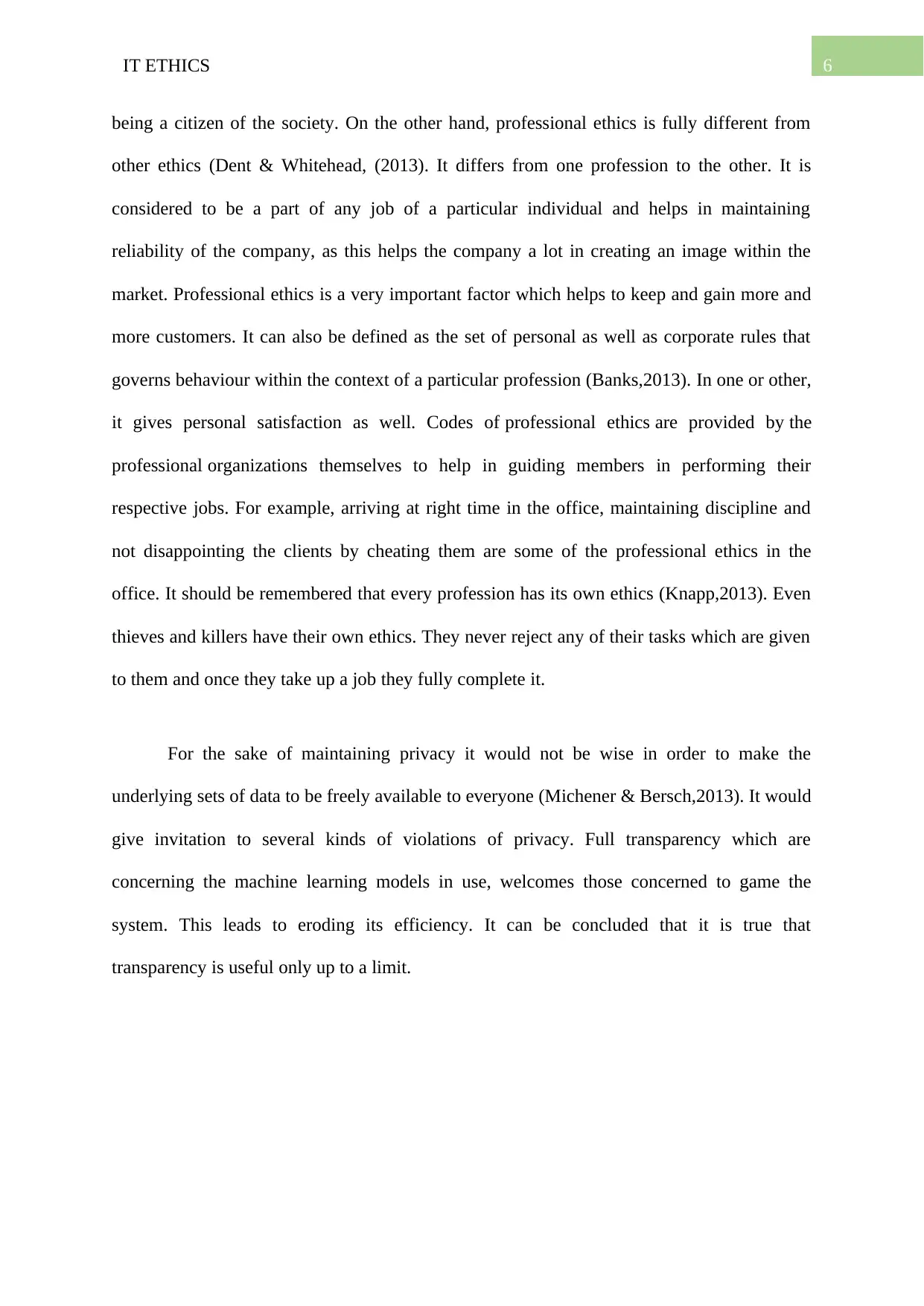
6IT ETHICS
being a citizen of the society. On the other hand, professional ethics is fully different from
other ethics (Dent & Whitehead, (2013). It differs from one profession to the other. It is
considered to be a part of any job of a particular individual and helps in maintaining
reliability of the company, as this helps the company a lot in creating an image within the
market. Professional ethics is a very important factor which helps to keep and gain more and
more customers. It can also be defined as the set of personal as well as corporate rules that
governs behaviour within the context of a particular profession (Banks,2013). In one or other,
it gives personal satisfaction as well. Codes of professional ethics are provided by the
professional organizations themselves to help in guiding members in performing their
respective jobs. For example, arriving at right time in the office, maintaining discipline and
not disappointing the clients by cheating them are some of the professional ethics in the
office. It should be remembered that every profession has its own ethics (Knapp,2013). Even
thieves and killers have their own ethics. They never reject any of their tasks which are given
to them and once they take up a job they fully complete it.
For the sake of maintaining privacy it would not be wise in order to make the
underlying sets of data to be freely available to everyone (Michener & Bersch,2013). It would
give invitation to several kinds of violations of privacy. Full transparency which are
concerning the machine learning models in use, welcomes those concerned to game the
system. This leads to eroding its efficiency. It can be concluded that it is true that
transparency is useful only up to a limit.
being a citizen of the society. On the other hand, professional ethics is fully different from
other ethics (Dent & Whitehead, (2013). It differs from one profession to the other. It is
considered to be a part of any job of a particular individual and helps in maintaining
reliability of the company, as this helps the company a lot in creating an image within the
market. Professional ethics is a very important factor which helps to keep and gain more and
more customers. It can also be defined as the set of personal as well as corporate rules that
governs behaviour within the context of a particular profession (Banks,2013). In one or other,
it gives personal satisfaction as well. Codes of professional ethics are provided by the
professional organizations themselves to help in guiding members in performing their
respective jobs. For example, arriving at right time in the office, maintaining discipline and
not disappointing the clients by cheating them are some of the professional ethics in the
office. It should be remembered that every profession has its own ethics (Knapp,2013). Even
thieves and killers have their own ethics. They never reject any of their tasks which are given
to them and once they take up a job they fully complete it.
For the sake of maintaining privacy it would not be wise in order to make the
underlying sets of data to be freely available to everyone (Michener & Bersch,2013). It would
give invitation to several kinds of violations of privacy. Full transparency which are
concerning the machine learning models in use, welcomes those concerned to game the
system. This leads to eroding its efficiency. It can be concluded that it is true that
transparency is useful only up to a limit.
Paraphrase This Document
Need a fresh take? Get an instant paraphrase of this document with our AI Paraphraser
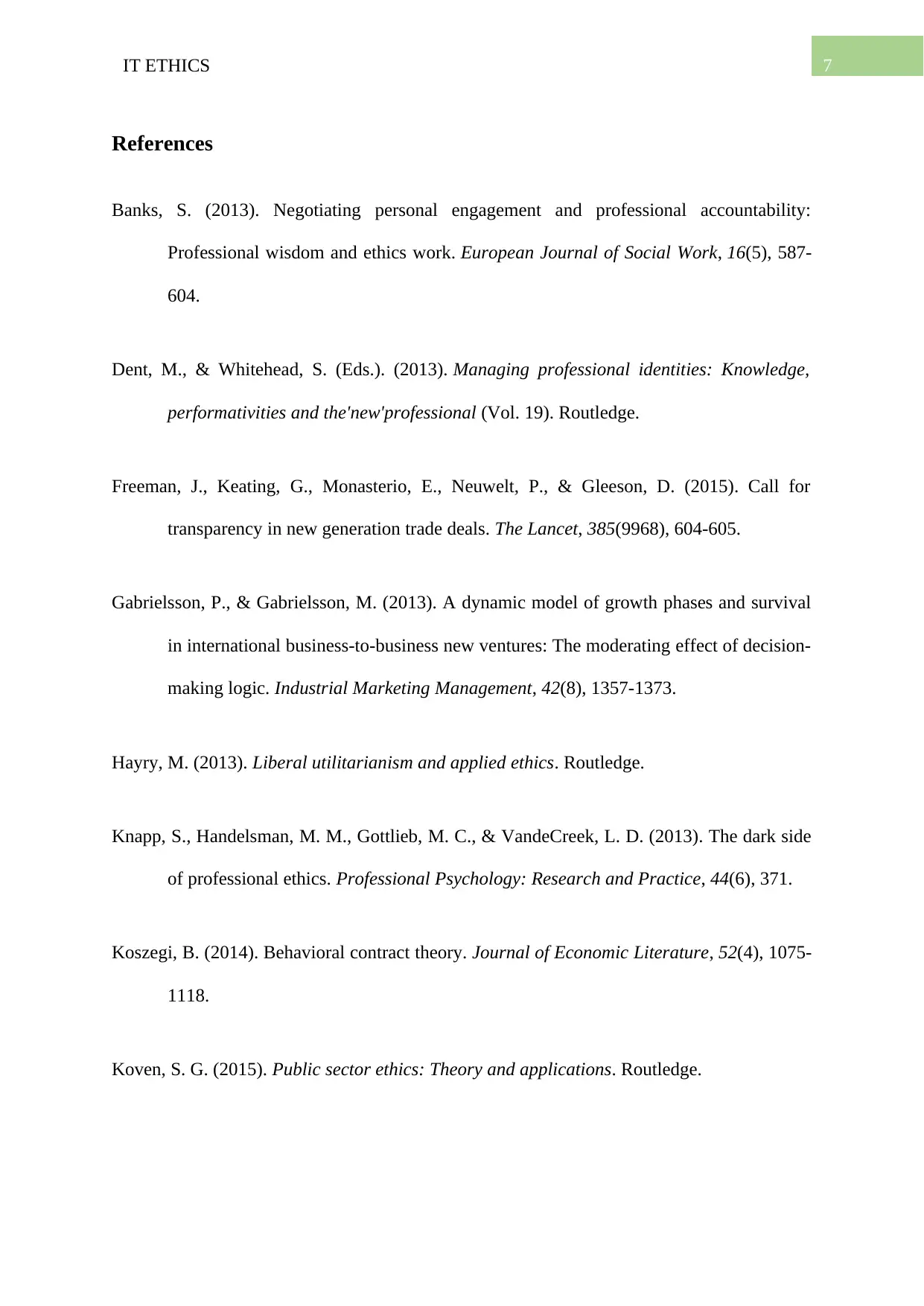
7IT ETHICS
References
Banks, S. (2013). Negotiating personal engagement and professional accountability:
Professional wisdom and ethics work. European Journal of Social Work, 16(5), 587-
604.
Dent, M., & Whitehead, S. (Eds.). (2013). Managing professional identities: Knowledge,
performativities and the'new'professional (Vol. 19). Routledge.
Freeman, J., Keating, G., Monasterio, E., Neuwelt, P., & Gleeson, D. (2015). Call for
transparency in new generation trade deals. The Lancet, 385(9968), 604-605.
Gabrielsson, P., & Gabrielsson, M. (2013). A dynamic model of growth phases and survival
in international business-to-business new ventures: The moderating effect of decision-
making logic. Industrial Marketing Management, 42(8), 1357-1373.
Hayry, M. (2013). Liberal utilitarianism and applied ethics. Routledge.
Knapp, S., Handelsman, M. M., Gottlieb, M. C., & VandeCreek, L. D. (2013). The dark side
of professional ethics. Professional Psychology: Research and Practice, 44(6), 371.
Koszegi, B. (2014). Behavioral contract theory. Journal of Economic Literature, 52(4), 1075-
1118.
Koven, S. G. (2015). Public sector ethics: Theory and applications. Routledge.
References
Banks, S. (2013). Negotiating personal engagement and professional accountability:
Professional wisdom and ethics work. European Journal of Social Work, 16(5), 587-
604.
Dent, M., & Whitehead, S. (Eds.). (2013). Managing professional identities: Knowledge,
performativities and the'new'professional (Vol. 19). Routledge.
Freeman, J., Keating, G., Monasterio, E., Neuwelt, P., & Gleeson, D. (2015). Call for
transparency in new generation trade deals. The Lancet, 385(9968), 604-605.
Gabrielsson, P., & Gabrielsson, M. (2013). A dynamic model of growth phases and survival
in international business-to-business new ventures: The moderating effect of decision-
making logic. Industrial Marketing Management, 42(8), 1357-1373.
Hayry, M. (2013). Liberal utilitarianism and applied ethics. Routledge.
Knapp, S., Handelsman, M. M., Gottlieb, M. C., & VandeCreek, L. D. (2013). The dark side
of professional ethics. Professional Psychology: Research and Practice, 44(6), 371.
Koszegi, B. (2014). Behavioral contract theory. Journal of Economic Literature, 52(4), 1075-
1118.
Koven, S. G. (2015). Public sector ethics: Theory and applications. Routledge.
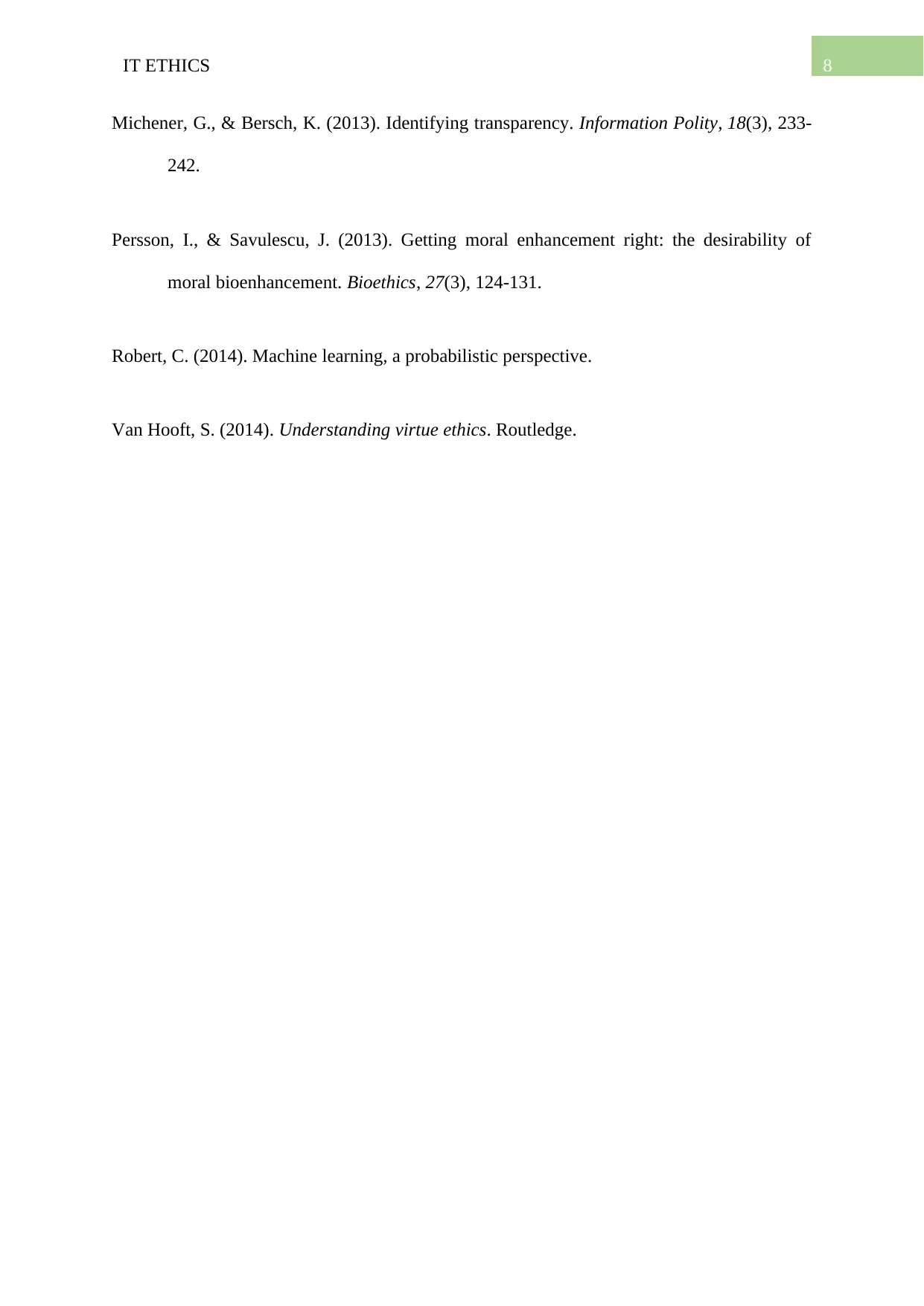
8IT ETHICS
Michener, G., & Bersch, K. (2013). Identifying transparency. Information Polity, 18(3), 233-
242.
Persson, I., & Savulescu, J. (2013). Getting moral enhancement right: the desirability of
moral bioenhancement. Bioethics, 27(3), 124-131.
Robert, C. (2014). Machine learning, a probabilistic perspective.
Van Hooft, S. (2014). Understanding virtue ethics. Routledge.
Michener, G., & Bersch, K. (2013). Identifying transparency. Information Polity, 18(3), 233-
242.
Persson, I., & Savulescu, J. (2013). Getting moral enhancement right: the desirability of
moral bioenhancement. Bioethics, 27(3), 124-131.
Robert, C. (2014). Machine learning, a probabilistic perspective.
Van Hooft, S. (2014). Understanding virtue ethics. Routledge.
⊘ This is a preview!⊘
Do you want full access?
Subscribe today to unlock all pages.

Trusted by 1+ million students worldwide
1 out of 9
Related Documents
Your All-in-One AI-Powered Toolkit for Academic Success.
+13062052269
info@desklib.com
Available 24*7 on WhatsApp / Email
![[object Object]](/_next/static/media/star-bottom.7253800d.svg)
Unlock your academic potential
Copyright © 2020–2025 A2Z Services. All Rights Reserved. Developed and managed by ZUCOL.




